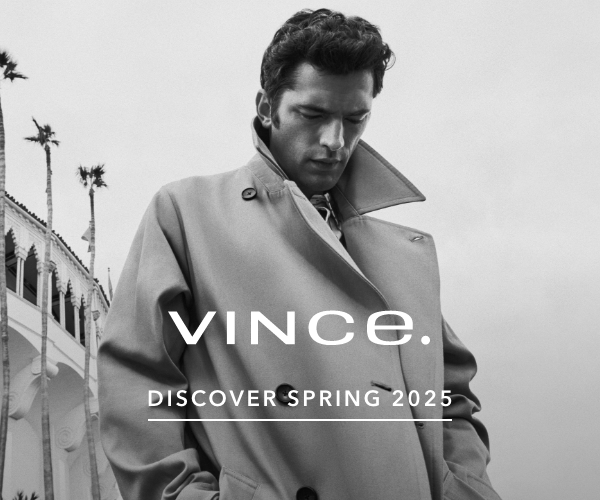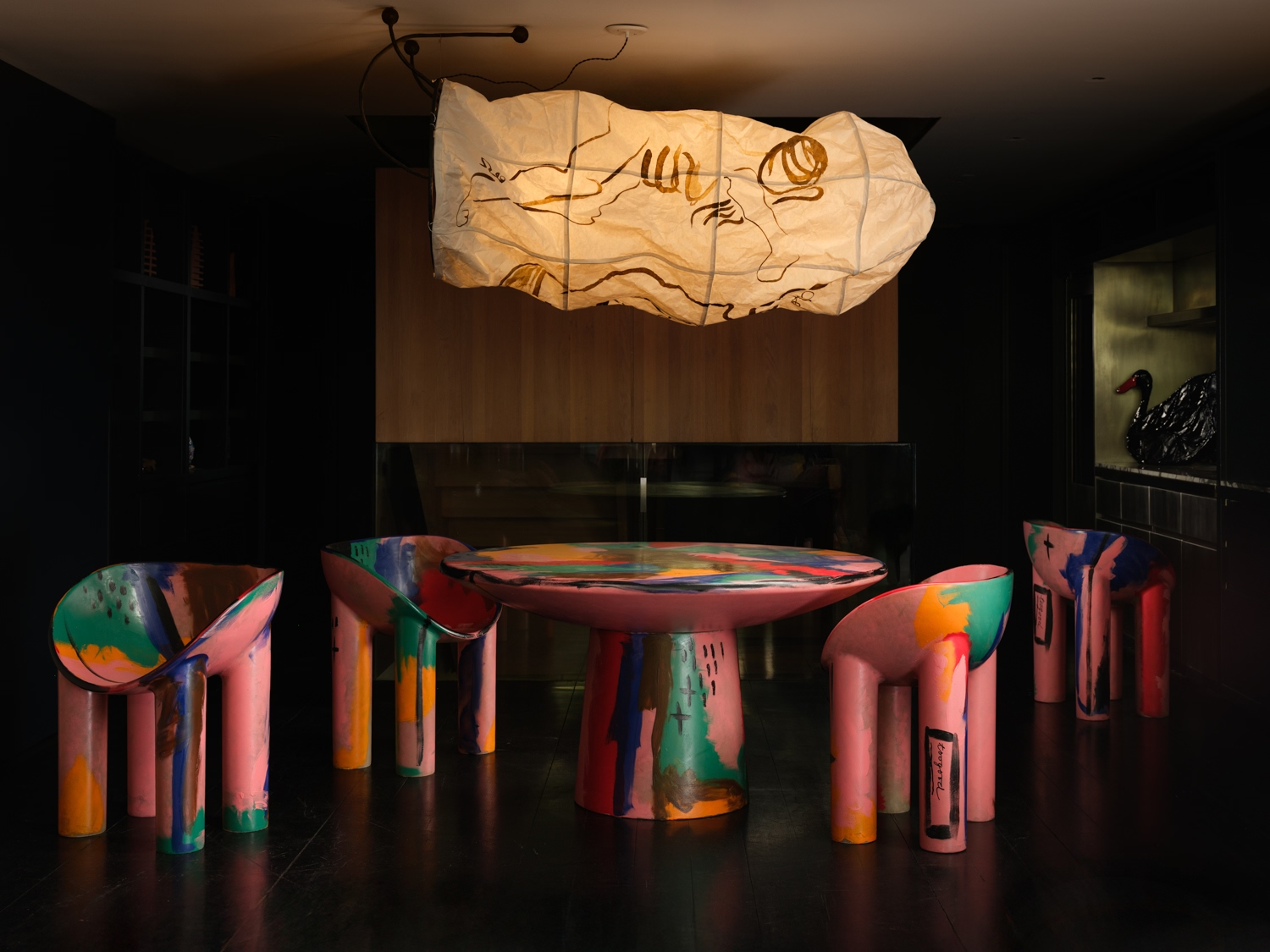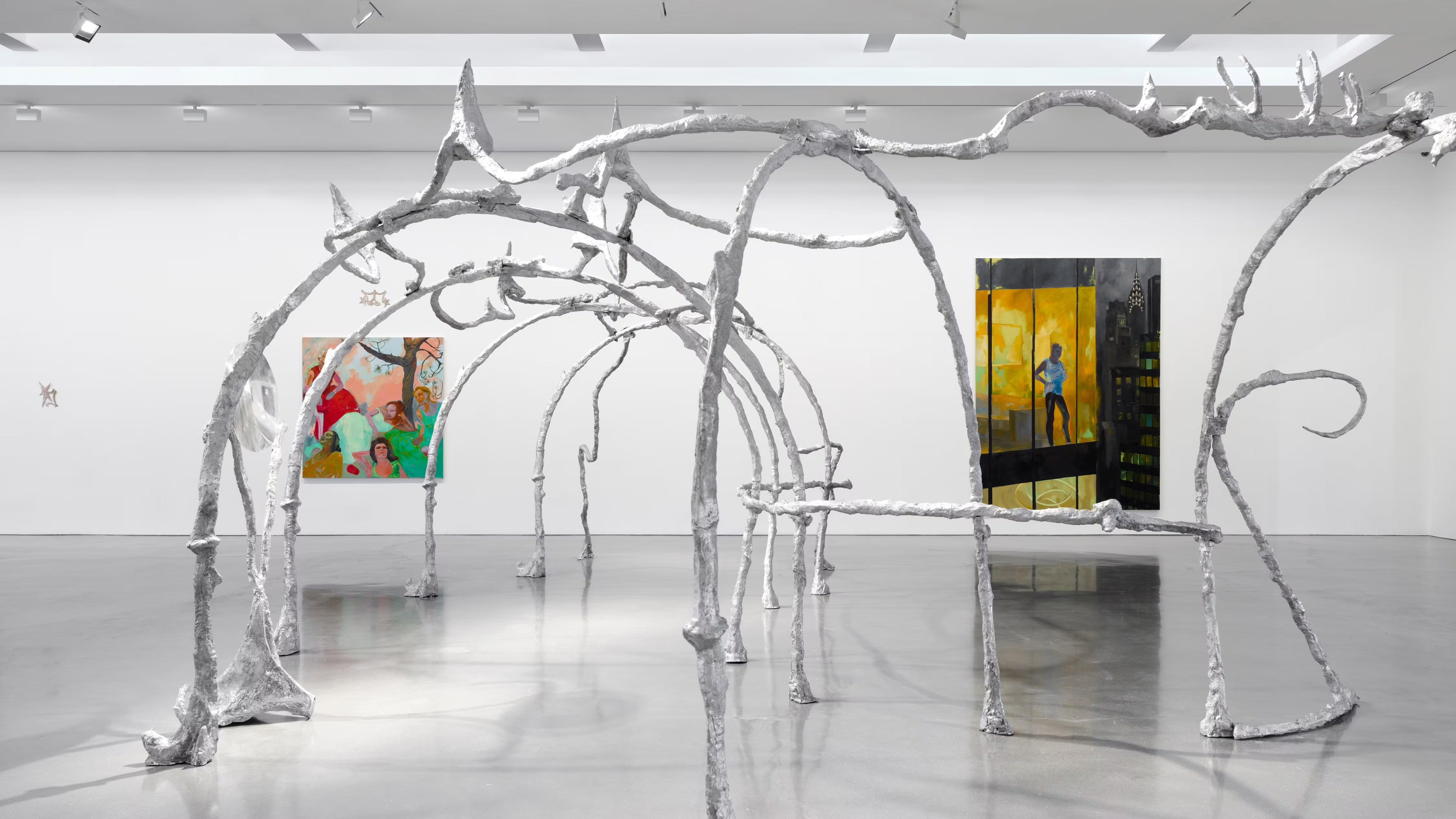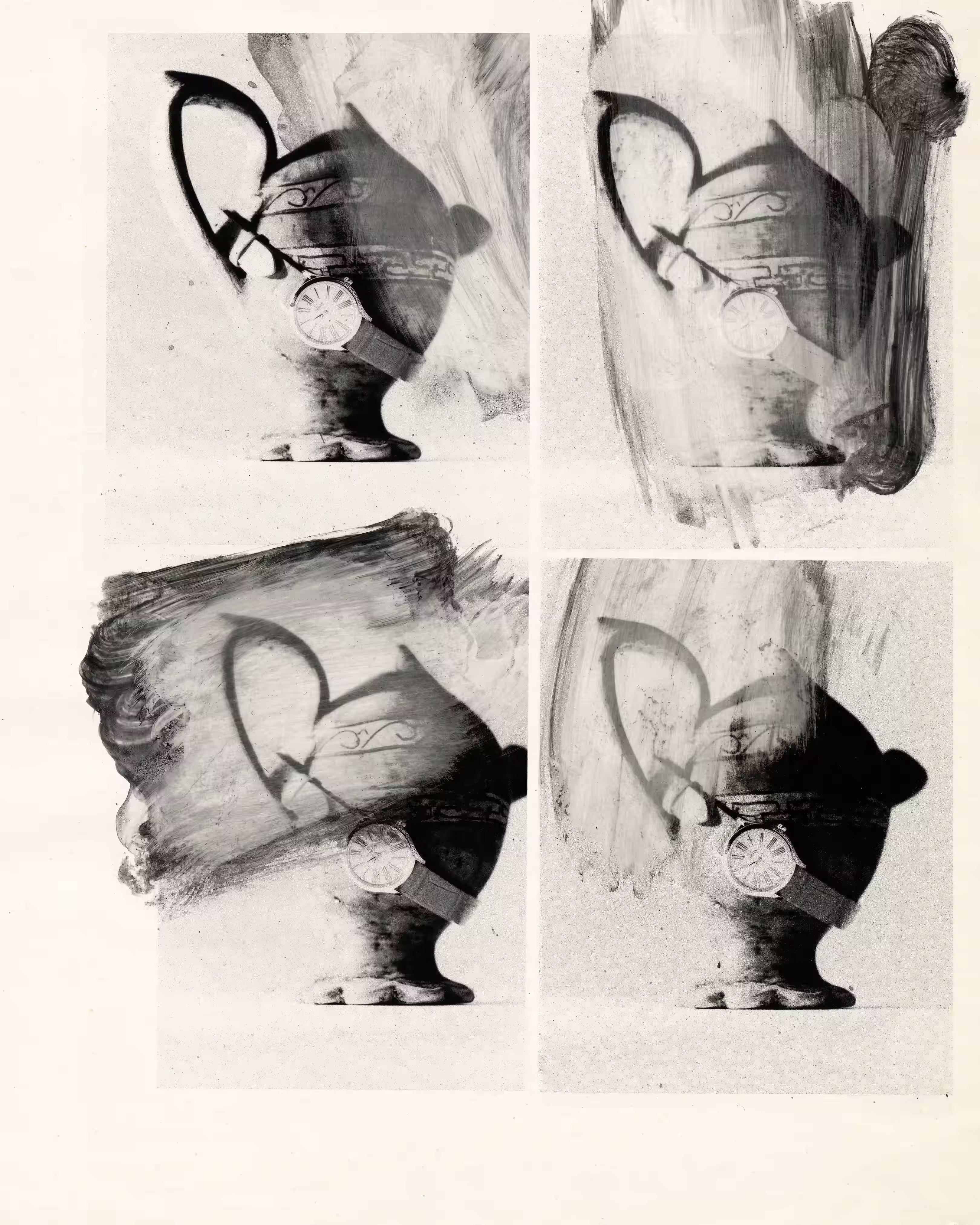
Tamo Jugeli is walking me through her solo show “Hey” at Karma Los Angeles. Rather than explaining the full picture, she encourages me to decipher half-hidden cues and hints. As she tells me how she resists biographical or structural readings of her works (all made in the last year), I am struck by her resolute clarity. Her rigorous processual and conceptual choices allow for the inherent mystery of painting to unfold on its own as if evoking a primordial goo.
In Puddle of water, which depicts a puddle capturing a cloudy sky as if a mirror—with soft, diffused light filtered through, set against wet mud, grass, or gravel—colors ooze into neighboring zones, the drips and drops preserved. A textured patchwork pattern in the lower right recalls a blanket gifted to the artist by her grandmother many years ago. Yet, Jugeli only retroactively made this association after the work was finished. In Bridge, anonymous body parts from the past resurface. Across the gallery, there is a radical self-trust in the artist’s paintings, a quasi-spiritual precision and control of visual references. Her sense of exactly what should go where is an intuition that cannot be reduced to automatism.

It is hard to believe Jugeli never picked up a paintbrush until the age of 22. The Georgia-born artist started painting after she graduated university with a bachelor’s in journalism. Stuck at a day job editing video for T.V., she felt angry and anxious. “It offered nothing to spark my interest, challenge me, or feed my mind, ” Jugeli recalls. She lost her grip, and became unsure of who she was. Perhaps she was mirroring the conditions of her home country cast under the shadow of Russia and subsumed by the influence of its formidable, expansionist neighbor. So, she turned to painting, a purposeful outlet to display such mental anguish on canvas.
Such an artistic pursuit looks beyond the nihilism of Jugeli’s generation, those who see their strife for freedom as futile at worst and constrained at best. To aspire beyond such a nihilistic worldview is both a burden and a gift. Jugeli’s early works carry this freedom of learning, of refusing familiar paradigms, of seeking a larger stage to enact her productive desires. With every confessional painting, she set her own terms and conditions. This required “tremendous energy, curiosity, and obsession with work,” she reflects. Two years into her practice, Gallery Artbeat, a powerhouse in the Tbilisi art scene, offered her a solo show that put her uncompromising dance between mysticism and sensuality on the map.
_result.avif)
When the gallerist Polina Berlin presented the artist with the opportunity to leave Tbilisi to work on new paintings for a few months in New York City in 2022, she took it. This led to Jugeli’s solo show, “Solitaire,” at the Manhattan gallery in May 2022. There, she responded to the metropolitan landscape, simultaneously contrived and expansive. Being in New York felt natural for Jugeli, who has claimed the city as her primary residence ever since. “The move was just organic, smooth. It happened as if it was meant to be,” she says of her chosen home. Five-thousand-six-hundred miles away from Tbilisi, Jugeli’s mind was free to forge new paths and discover a new artistic community. “I’m incredibly lucky, in a way that’s hard to put into words,” she adds.
“Living in LA for the past four months has had a profound effect on me. It’s very Lynchian, beautiful, yet ugly and dark at the same time.” confesses Jugeli, who made the move to work on “Hey.” When asked what her favorite elements of her new second home are, she turns to me and describes its almost magical light, its quiet and open landscape, tall palms, and the strange, seductive rhythm of travelling through its many hidden pockets. The high of experiencing a place situated somewhere between a make-believe and a mood board has clearly left marks upon her new paintings—but her brush is attuned to auras, flows of energy, and states of feeling, rather than specific representations. Here in LA, where hours are spent driving in cars and popular culture is a main export, days feel longer than they need to be, one thing could mean another a few moments later, and patience is truly a virtue. Perhaps, more so ever than anywhere else, it is impossible to establish rigid boundaries between the truth and aesthetic production. And so, in Jugeli’s paintings, meaning and authorship become entangled.

The artist used to think authenticity only meant intuition. Or, in her words, “the purest form of creation was only instantaneous, born from instinct, and that anything requiring patience or deliberation was somehow forced.” In Los Angeles, she decided to title her paintings for the first time. She’s realized that for the meaning of her work to be fully expressed, she must acknowledge that she is not working in isolation, but rather along with influences, afterthoughts, chance, and accident.
In this sense, Morandi is a quiet ode to the early 20th century Italian painter Giorgio Morandi’s muted palette and soft yet rich texture. “He needed so little, so few colors,” Jugeli tells me. “I’ve always admired painters who can work within such limitations and still create wonders.” When she first nearly finished the work, which originally depicted an abstract, quiet alcove of time, with ochre, ash, and the faintest blush of gray brushstrokes: it felt “too perfect, too beautiful,” she shares. With only a few days left to complete it, she took a hardware tool and scratched the whole surface of it. The resulting marks appear as impressions and afterimages rather than strokes of paint. As she tells it, a leap into the unknown saved the painting. At that moment, Jugeli came to the epiphany: that “in destruction, there’s always the potential for something more.”

This embrace of external influences will follow the artist back to New York, where she will work on a new body of work in the artist Amy Sillman's Long Island studio, as she gears up for her next show in Brussels at Gladstone Gallery later this May. “It’s going to be special, working in a space that holds so much of her energy, where many of the paintings I love were made,” Jugeli says of the painter who is her friend. “I feel like a vessel, absorbing new moods, new colors, new philosophies.”
"Hey", is on view until February 13th, 2025, at Karma Gallery at 7351 Santa Monica Boulevard, Los Angeles.











.avif)








.avif)


_result_result.avif)



.avif)

_result_result.avif)

_result_result.avif)
.avif)

_result_result.avif)


_result_result.avif)


.avif)




.webp)

.avif)



















%20(1).avif)
.avif)




.avif)
















.avif)


.avif)





















.jpeg)

.avif)

_11%20x%2014%20inches%20(2).jpg)







.avif)

.jpg)

%20(1).jpg)
.avif)
.jpg)

.jpg)
.webp)


.webp)



.webp)


.webp)


.avif)









.avif)
.avif)

















.avif)









.avif)



.avif)



















-min_result.avif)









.avif)







3_result.avif)
_result.avif)






_result.avif)




.avif)




.avif)













.avif)

.avif)











.avif)

.avif)










.avif)



.avif)


_result_result.avif)
















-min_result.avif)






.avif)
.jpg)
















_result.avif)

.avif)


.avif)







.avif)





.avif)

_result.avif)



.avif)















.avif)









.avif)


.avif)














.avif)




.avif)








.avif)

.avif)

.avif)



.avif)


.avif)




.avif)

.avif)

.avif)
.avif)
%20(1).avif)
.jpg)

%20(1).avif)








.avif)
.avif)

.avif)






.avif)



















.avif)
.avif)
